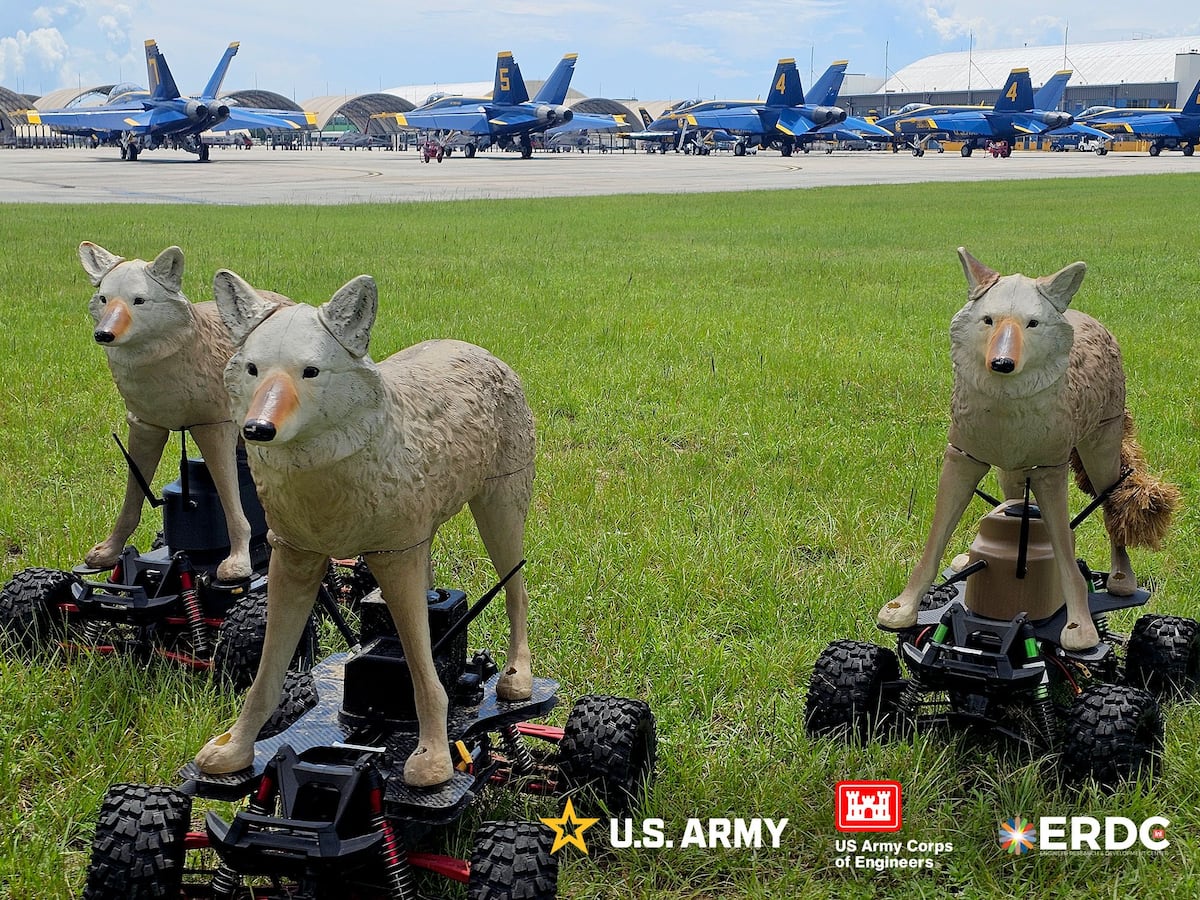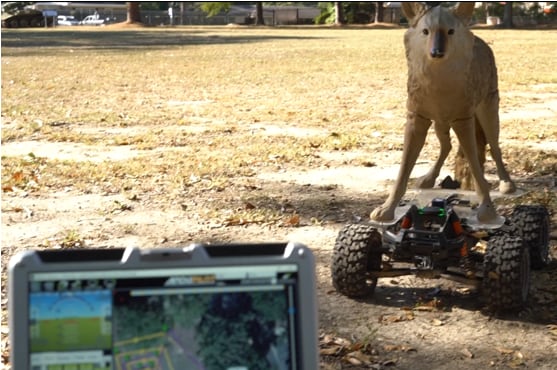Army tests robotic coyotes to defend fighter jets

Sure, “robots versus birds” may sound like a low-budget sci-fi movie franchise. But for the Army Corps of Engineers’ Engineer Research and Development Center, it’s actually a savvy solution to a problem that has long threatened the military’s most sophisticated and powerful aviation platforms at their home stations.
ERDC is working on prototypes of unmanned ground vehicles, or UGVs, that can be deployed across airfields to scare off birds and other problematic wildlife that could do millions of dollars’ worth of damage, or even threaten aircrew lives by flying into the engine.
A photo released by the center demonstrates one vision for the technology: three four-wheeled UGVs mounted with life-size plastic coyote figures, standing sentry over the Navy’s elite Blue Angels fighter jet demonstration team.
“That was, I guess, the money shot,” said Shea Hammond, a research biologist focused on Robotic Characterization of Battlefield and Operational Environments for ERDC. He and Dr. Jacob Jung, an ERDC research wildlife biologist focused on Bird/wildlife Aircraft Strike Hazard, or BASH, have collaborated over the last five years in developing the “Coyote Rovers.”
The UGVs remain in prototyping, but have been used in test demonstrations at multiple airfields including Naval Air Station Pensacola, Florida, where the Blue Angels train.
BASH, and more broadly wildlife activity around delicate and sophisticated equipment, have long posed a problem for the Defense Department, requiring creative and oddball solutions.
In Bangor, Washington, the Navy has hired hawk handlers to drive away seagulls that were damaging submarines and harassing workers. The Air Force has special radars for detecting birds and a monitoring system that reports “bird strike risk intensity levels” from zero to eight. Other programs have involved prairie dog mapping and putting GPS tracking collars on real coyotes, all to better mitigate bird and wildlife interference with military flights.
But the Coyote Rovers are not just expensive scarecrows. Rather, the design team said, they could represent a new way of deploying unmanned and autonomous technology that could benefit civil infrastructure authorities as well as the military.
“They basically have the same functionality as any other drone,” Hammond said. “We can program areas we want to exclude it from going, such as the airfield itself. We had worked on docking stations and recharging stations so it can operate on a programmed timer, so it can have utility for multiple days.”
Future versions, he said, could introduce artificial intelligence and machine learning skills that could take it well beyond the realm of Roomba-style robotic technology.
Feasibly, Hammond said, the rovers could be trained to identify specific species of birds or wildlife in their zones of operation and employ different tactics or approaches for specific species. Upgrades to the vehicle could also increase its ruggedness and ability to operate on different kinds of terrain and in all weather.
For the Army Corps of Engineers, which maintains the nation’s locks and dams, systems like this could also ward off wildlife prone to nesting and defecating on infrastructure, causing costly wear and tear.
Hammond noted that ERDC has at times employed live dogs to scare off unwelcome creatures — a job that could be done more predictably by robots.
Jung suggested that the same technology that powers the rovers could be transferred to boats or hovercrafts to push away nuisance wildlife in aquatic environments. At some remote bases, an upgraded version of the rover might even perform security watchstander duties, they suggested.
As research and development has so far shown, the most expensive or elaborate robot is not always the best one for the job. Hammond and Jung said they began with a Boston Dynamics quadruped robot — the “Spot” version looks similar to a dog — but found its slow approach speed on four legs didn’t really intimidate wildlife as intended.

“What we found out quickly was, because it had such a slow approach speed, that it did more of just pushing animals out of the way once it finally got close enough to them, than it did really scaring them off,” Jung said.
The base that worked better was a four-wheeled one from Traxxas X-Maxx, a company known for radio-controlled cars. It could reach up to 20 miles per hour, fast enough to send wildlife running. And, including the coyote figurine purchased from a forestry supplier, the demo system cost between $2,500 and $3,000.
In demonstrations — which have also taken place at Fort Campbell, Tennessee, among Army helicopters, as well as Naval Air Station Whiting Field, Florida, where Navy, Marine Corps and Coast Guard helicopter pilots are trained — the value proposition has been clear, Jung and Hammond said.
At many airfields, regular grass mowing is a major and costly wildlife deterrent effort. The UGVs can help reduce that cost, Hammond said.
“Even at a small number of airfields, if you can give them one more week between mowing, that ends up being a huge [cost savings],” Hammond said. “And so, can these systems provide that deterrence, to provide them an extra week or an extra two weeks on maintenance.”
Follow-on testing of the rovers is expected to take place this summer, if the funding comes through, they said.
Read the full article here









